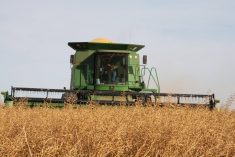HANOVER, Germany — Electricity is coming to a field near you, but it won’t need a mile of extension cord.
The only power on a tractor has traditionally been the 12 volts coming off the alternator.
However, new machinery designs are turning to electricity to deliver energy to operations once the mandate of hydraulics, power take-offs, ground drives and accessory drives.
“Mechanical drives aren’t very efficient,” said Ulrich Huber of electrical technology company STW. “They are poor at transferring power from one place to another once it is made.”
Read Also

Crop quality looks good this year across Prairies
Crop quality looks real good this year, with the exception of durum.
Huber’s German company brought a 140 kilowatt generator mounted to a Fendt tractor to Germany’s recent Agritechnica farm show in Hanover to show off what it could do with electricity to replace typical p.t.o. and hydraulic systems.
“This is nothing new for mining or other industries, only in agriculture have we avoided it, until now,” he said.
“It is a better way to deliver power: more efficient and well proven.”
STW was not alone in showing off its diesel engine powered, electric-hybrid tractor.
Deere, Deutz, Rigitrac, Agco and Belarus also brought electrical solutions to Agritechnica. They say it is more than a passing fad.
“It’s a trend that goes hand in glove with precision agriculture, rising fuel prices and maintenance costs,” Huber said.
Power generated either from a p.t.o. mounted generator, which is the STW solution, or from more common flywheel mounted generators provides energy through cables to electric motors that drive a variety of functions on equipment.
Deutz-Fahr plans to power balers and other tools with electricity.
Age Krug of Agco Challenger in the Netherlands said his company’s prototype Electrogator, a diesel-over-electric sprayer with electrically powered wheel motors, is destined for production in coming years.
“It is about efficiency and precision,” Krug said.
“We were able to control wheel spin and improve ground contact, use less fuel and improve our application procedures. Our new non-electric sprayer in Europe benefited from what we have seen from the prototype about wheel spin.”
Much of the efficiency is created by the ability to disconnect machinery from the engine and run the various components at ideal speeds or selectively shut off systems when they are parasitic on the machine.
A fertilizer spreader from Rauch operates its spinners with electric motors, providing variable rate applications and shut offs for an entire side at field edges and overlaps.
Electric motors have other benefits as well.
High torque motors don’t give up power as readily as other drives, can increase and decrease speed more rapidly and are able to compensate for changes in ground speed independently from the motion of the machine.
When Agco debuted its Electrogator sprayer at Ag Connect in Orlando, Florida, last year, it predicted that its new large-square baling system that trailed its combines would eventually be electrically driven rather than depending on long hydraulic feeds from the combine.
Rigitrac offers an electrically driven tractor capable of precision operating speeds and up to 15 percent fuel savings. It won an innovations award at this year’s Agritechnica for the machine.
Marlin One, a senior standards engineer with John Deere, said electric systems aren’t new to agriculture but failed to catch on in an era of low fuel prices and plentiful machinery mechanics.
The Farmall 450 of the 1950s had an IH Electrall option that used an engine-mounted generator that fed motors on farm implements.
Deere now makes a 7530 E in North America and a 6030 in Europe. Electricity is generated from the crankshaft with an electrically driven cooling system, air conditioning and air brake compressors and power for farm implements. It can also connect to a 110 volt power system so it can act as a emergency or mobile farm power supply.
First at Agritechnica two years ago, Belarus introduced its 3023 tractor with an electrically driven front p.t.o.
The Deutz ZT-Terra+ tractor can add wheel motors to implements to boost stop and start loads as well as p.t.o. driven processes, which reduces engine load when it is least efficient.
The company said the strategy improves fuel efficiency by up to 10 percent. As well, using electric motors in place of crankshaft driven tractor auxiliaries such as cooling and other pumping can produce savings of five percent.
In a recent American Society of Agricultural and Biotechnological Engineers Association publication, the Deere tractor was shown to be 13.8 percent more fuel efficient running a power harrow and 9.3 percent better when pulling a trailer than its 7530 all-diesel sister machine.
Germany’s DLG, which organizes Agritechnica, also tests farm equipment. It found the electrical machine was five percent more efficient.
Huber said the generators will become larger and controllers more sophisticated. However, most of the technology transition will take place with the introduction of implements that can use the new energy source.
“You will still have your p.t.o. and hydraulics, but you will also have some large electrical connectors as well,” he said.














